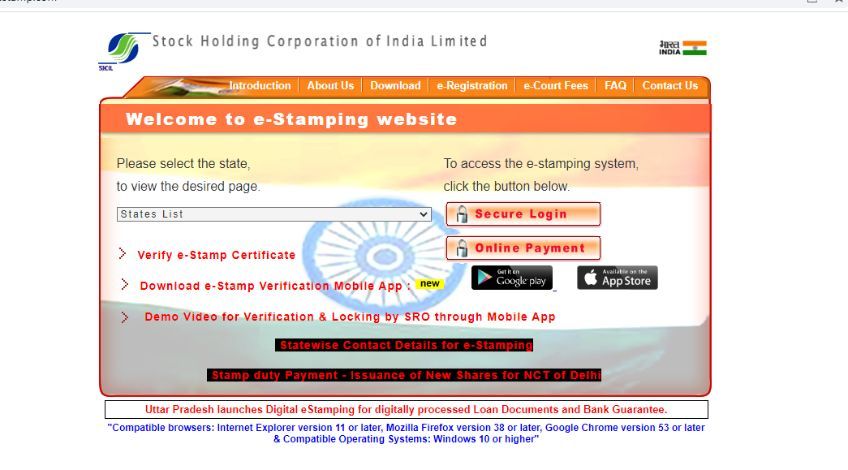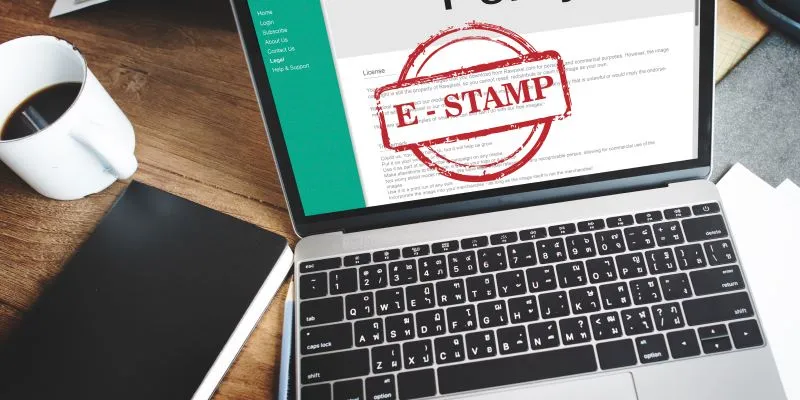Table of Content
To purchase, sell, create a deed, or even rent your property, you must pay stamp duty to the central or state authorities. Electronic stamping, or e-stamping, is a method of paying this non-judicial stamp duty electronically. Previously, you had to visit the sub-registrar's office physically to pay the stamp duty for property registration. Now, with the e-stamping process, most of it can be done online. This article will help you understand the concept of e-stamping, how to do it online, download e-stamped papers, and much more.
Currently, 30 states and Union Territories (UTs) follow the India Stamp Act of 1899, while around six states and UTs have their own Stamp Acts. States and UTs that have adopted the digital e-stamping process have made specific modifications according to their own rules and regulations. Therefore, there is no standardization across the country.
What is an estamp paper?
E-stamp paper is a process that allows stamp duty to be paid electronically to the government. The government has replaced the traditional paper and franking stamping methods with this digital approach to ensure a faster and more hassle-free payment process. This service is currently available in 22 states across India. Maharashtra, however, has its own electronic stamp duty payment system.
When was the estamp paper launched in India?
The Indian Government introduced the e-stamping facility in July 2013 to reduce fraud and errors associated with paying stamp duty. The Stock Holding Corporation of India Limited (SHCIL), acting as the Central Record Keeping Agency (CRA), is responsible for issuing e-stamp certificates in India. Instead of the CRA, Authorized Collection Centers (ACCs), which can be scheduled banks or post offices, are designated intermediaries responsible for issuing e-stamp paper. Each state government has several ACCs to facilitate this process.
Different modes to pay the fee at the stamping portal
In India's stamping system, you can pay the fee using the following methods:-
- Cheque
- Cash
- Demand Draft
- NEFT
- RTGS
- Pay Order
- Account transfer
Also Read: What does the Married Women’s Property Act entail?
States and Union Territories offering e-stamping services
Currently, SHCIL offers e-stamp services in 21 states. However, in Maharashtra, SHCIL does not handle e-stamping. Instead, in 2013, Maharashtra introduced a new online stamp duty payment system known as the Electronic Secured Bank Treasury Receipt (eSBTR) payment portal.
The 21 states under SHCIL that offer e-stamp online are as follows:
- Andman and Nicobar
- Andhra Pradesh
- Bihar
- Chhattisgarh
- Chandigarh (Union Territory)
- UT of Dadra and Nagar Haveli and Daman and Diu
- Delhi
- Gujarat
- Himachal Pradesh
- Jammu and Kashmir
- Karnataka
- Ladakh (Union Territory)
- Meghalaya
- Odisha
- Puducherry
- Punjab
- Rajasthan
- Tamil Nadu
- Tripura
- Uttar Pradesh
- Uttarakhand
Process to get documents estamped
Obtaining e-stamped property documents has become very simple. You can pay the stamp duty fee online and download the certificate. Follow these steps to e-stamp your documents.
Step 1: Visit the official website of the SHCIL https://www.stockholding.com/estamp-index.html

Step 2: Click on e-Stamp Services.
Step 3: Select the appropriate state where you want to pay the stamp duty; the stamp duty charges in every city may vary.

Step 4: Fill out the application form and click on the Download tab. You can download the form without payment if the stamp duty is less than Rs 501.
Step 5: After clicking the Download tab, you will get the stamp certificate.
Also Read: What is a leave and licence agreement?
How to pay stamp duty SHCIL estamp portal
There are various payment modes available for e-stamp paper registration, including cash, cheque, NEFT, RTGS, and account transfer.
1.Register: Click the 'Register Now' button to sign up as a new SHCIL user.
2.Fill Details: Enter your User ID, password, security question, and bank account details.
3.Activation: Confirm your registration through the activation link sent to your email. Use your User ID and password to access services.
4.Login: Log in with your activated User ID and password.
5.Select State: Choose the state where you want to pay the stamp duty.
6.Create Referral: Select the 'Nearest SHCIL Branch' option to create a referral number for payment via net banking, debit card, NEFT, RTGS, or FT. This step requires details like First Party Name, Second Party Name, Article Number, Stamp Duty Payable, and Stamp Duty Amount.
7.Get E-Stamp: Print the Online Reference Acknowledgement Number and take it to the nearest Stock Holding Branch to get the final e-stamp paper printout.
Note: Citizens must pay payment gateway charges. Residents of NCT of Delhi, Karnataka, Himachal Pradesh, UT of Ladakh, Chandigarh, Jammu and Kashmir, Puducherry, and Andaman & Nicobar can make the payment online and print the e-stamp certificate from home.
Process of e-stamped verification
Perform the following steps for e-stamp verification:-
Step 2: Enter the state, certificate number, stamp duty type, issuance date and session ID, and click on the 'Verify' button
Verify e-stamp paper using mobile app
You can verify e-stamped paper using the E-stamping mobile app, available on the App Store and Play Store. This app provides two verification options: scanning the QR code on the e-stamp paper or manually entering the details. Note that the QR code is not available on certificates generated before February 13, 2019.
To scan a QR code, open the app and use the camera feature. All the details will be displayed once the code is scanned.
For manual verification, click the manual button and select the state. Then, enter the certificate number, the date the certificate was issued, the unique document number, amount reference, purchaser details, document description, stamp duty amount, consideration price, and the names of the first and third parties.
Also Read: How to remove co-owner name from property title deed?
Fees for estamp online services
Advantages of e-stamping
- Pay conveniently at your comfort
- The stamp paper is generated in minutes
- No additional charges levied
- It is a tamper-evident, and it has a unique identification number
- Data is saved with SHCIL
- E-stamping is tamper-proof.
- Verification of genuineness can be done using an inquiry model.
Is it possible to get a duplicate estamp certificate?
Use of eStamping by Businesses
Businesses across different industries use e-stamping for a wide range of purposes, including:
- attesting to the legality of official contracts
- Loan or finance loan agreements
- property purchasing and vending transactions
- leasing agreements
- onboarding activities of vendors
- human resource (HR) operations
- sale deeds
- affidavits, and other business agreements
Also Read: Stamp duty in UP and property registration charges for 2024
Is Getting an eStamp Paper Online Safe?
Yes, obtaining eStamp paper online is a secure method for paying non-judicial stamp duty to the government for legal documents and transactions. Here are key considerations to keep in mind:
- Ensure you use authorized government websites or licensed vendor portals to obtain eStamp paper to guarantee its authenticity.
- Before making any transactions, verify the legitimacy of the eStamp platform you are using.
- Keep a record of the transaction details and the unique identification code linked to the eStamp paper for future reference.
What You Should Know About E-Stamping
When dealing with E-stamping, it's crucial to remember a few key points:
1. Always keep a secure copy of your verification certificate as duplicates are not issued if the original is lost or misplaced.
2. To apply for a refund on a cancelled e-stamp, you must visit the Stock Holding Corporation of India Limited office.
3. In Maharashtra, the only accepted method for paying e-stamp fees is online.
4. An alternative online payment option for e-stamping is the Electronic Secured Bank Treasury Receipt (BTR). It ensures secure and timely payment of your e-stamp charges.
E Stamp: Contact Information
In case of any query or feedback, you can contact at the following address or email to the given address:-
Stock Holding Corporation of India Limited
301, Centre Point,
Dr. Babasaheb Ambedkar Road,
Parel, Mumbai - 400012
Maharashtra, India
Phone : 022 61779400-09
Email address: estamping@stockholding.com
Also Read: Stamp duty and property registration fees in Uttar Pradesh for 2024










Ans 1. 03 May 2024. E-stamp is a digital alternative to traditional stamp papers, revolutionising the stamping process. It involves the issuance of electronically generated stamps instead of physical documents.
Ans 2. In case you want to purchase stamp paper then just click "e-Stamp" option and fill up the relevant details and answers to security question and security code to generate e-Stamp. e-Stamp can be generated instantly in case of e-payment.
Ans 3. In rural areas of Haryana, the stamp duty applicable on such deeds is 5%, while in urban areas, it is 7% of the property's value. Gift Deed: When a property is gifted to another person without any exchange of money, a gift deed is executed.
Ans 4. Legal validity of e-Stamping E-Stamping holds the same legal validity as physical stamping. The certificates generated through the e-Stamping process are considered legally valid and are accepted by courts and government authorities as proof of payment of stamp duty.
Ans 5. BENEFITS of e STAMP PAPER ONLINE There are standard denomination of e stamp paper, like 20/-, 50/- and 100/- of non judicial stamp paper but one can get any desired value of e stamp paper of any denomination.
Ans 6. Step-by-step guide on how to obtain an e-stamp Provide transaction particulars, such as property details and involved parties. Complete electronic payments using various online options. Receive an instantly generated digital stamp certificate upon successful payment.